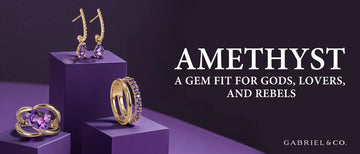
Those born in February, count your stars lucky—you were born in the eternal month of love. Referred to as the month of Saint Valentine, it’s a time filled with romance, heartfelt gestures, and wishful fantasies. But what is February’s birthstone? Amethyst. This captivating gem is not only the traditional birthstone for February but also a meaningful gift for those celebrating their 6th or 17th wedding anniversary. If you’re still wondering what to gift your beloved, amethyst jewelry is a beautiful choice.
Amethyst stands out with its rich color and the stories woven into its history. This February gemstone has been treasured for centuries, admired for both its beauty and meaning. Let’s explore what makes amethyst special—from its origins and symbolism to how you can wear and care for it.
Amethyst Stone History: From Greek Myths to Saint Valentine
The February birthstone is a purple variety of the mineral Quartz. Ironically, as intoxicating as the beauty of this purple stone is, its name means "remedy against drunkenness." Amethyst derives its identity from the Greek word amethystos, which means "guarding against excessive inebriation or indulgence."
Legends say that the Greek gods would prefer having their drinks in royal chalices embedded with amethyst stones, believing the balancing prowess of the rock would keep them from getting excessively drunk. Clearly, not the case, but the Greeks were quite fascinated with this unique gemstone.
As further testimony to the stone’s connection with deep love, Saint Valentine himself used to wear an amethyst ring with Cupid’s image carved in the center. These are folklore and fancy narratives passed on over generations, but it still amuses the heart to believe them. If Cupid’s arrow has struck you hard, with sweet rhapsodies of romance taking over your world, we say amethyst is the gemstone for you.

14K Yellow Gold Amethyst and Diamond Hoops
Amethyst Stone Benefits, Symbolism, and Meaning
Amethyst has long been a symbol of clarity, protection, and inner strength across cultures and centuries. In ancient Greece and Rome, it was believed to guard against overindulgence, which is why goblets were often carved from amethyst. Medieval soldiers wore amethyst into battle, believing it would keep them cool-headed and focused.
European royals saw it as a sign of wisdom and power, adorning crowns and scepters with deep purple stones to reinforce their authority. Eastern traditions embraced the healing properties of amethyst. The purple stone is tied to spiritual growth and protection, often used in meditation to quiet the mind and enhance intuition. Today, it remains a stone of calm and confidence—a quiet force wrapped in violet hues.
How is the Amethyst Stone Formed?
Amethyst forms when silica-rich fluids fill gas cavities in cooling lava. Over thousands or even millions of years, heat, pressure, and natural radiation cause quartz crystals to develop, with iron impurities giving them their signature purple hue. This process occurs deep within the Earth, often in volcanic rock formations.

Where is Amethyst Found?
While amethyst can be found worldwide, the most renowned deposits are in Brazil and Uruguay, where massive geodes filled with shimmering purple crystals are unearthed. Other sources include Russia, Zambia, and Madagascar, each producing amethysts with their own distinct color variations.
- From volcanic depths to breathtaking geodes, the formation of amethyst is a slow, natural process—one that turns simple minerals into a gemstone steeped in history and meaning.
What is February’s Birthstone Color?
Amethyst is known for its signature purple hue, but not all amethysts are created equal. The stone’s color can range from the softest lavender to deep, velvety violet, with every shade in between. What determines its color? A mix of iron content and natural radiation during its formation. The more iron and exposure to radiation, the richer the purple.
Some amethysts display flashes of red or blue within their depths, giving them a multidimensional glow. The most prized varieties include:
- Deep Siberian – A highly saturated purple with a balance of red and blue undertones.
- Rose de France – A lighter lilac shade with a soft, airy feel.
- Prasiolite – A green variety created through heat treatment.
- Citrine-like Amethyst – A golden-yellow shade formed by heating amethyst.
Some stones also show color zoning, where different shades of purple swirl together in the same crystal. Whether rich and royal or delicate and dreamy, amethyst’s range of hues makes it one of the most versatile and fascinating gemstones in the quartz family.

14K White Yellow Gold Diamond and Amethyst Pendant Necklace
Facts and Trivia About the February Birthstone
1. Before large amethyst quantities were discovered in Brazil in the 19th century, Russia used to be the primary source of the gemstone.
2. In the present day, Africa and South America provide most of the world’s amethysts.
3. In Africa, the Zambia mines are renowned for the excellent quality of amethyst crystals sourced from them. They’re highly pigmented with color and possess a bright luster.
4. Though the February birthstone is usually purple, the variety with striking red and violet hues imbued with purple is highly valued.
5. With the abundant reserves of the gemstone all over the world now, their price points have substantially lowered.
6. Amethyst tends to take on a yellowish tinge with excess heat treatment or prolonged exposure to direct sunlight, almost resembling citrine stone.
7. Leonardo da Vinci favored the stone, claiming it enhanced intelligence and warded off evil thoughts.
8. Given its calming effects, Buddhists use the gemstone in their meditative and prayer beads.
9. Catherine II, the empress of Russia, was obsessed with amethyst and adorned herself with magnificent jewelry featuring the gemstone.
Amethyst has an energy all its own—deep, mysterious, and impossible to ignore. For centuries, it’s been a symbol of wisdom and protection, worn by royalty and creatives alike.
Written By: Gabriel Editorial Team






























